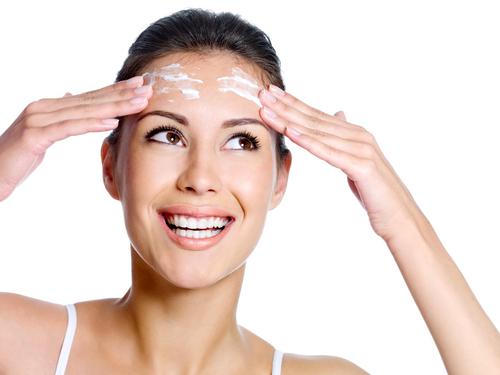Parabens in cosmetics

December 16, 2016
Let me take you through my morning beauty routine! My alarm blares at 5:45 AM every morning. My routine begins with washing my hair using my favorite methylparaben, condition with some ethylparaben, and wash with my butylparaben, which smells of coconut. After the shower I begin by applying some benzylparaben. Don’t forget to blend! I add some sparkly, pink isobutylparaben to my eye lids and finish with some n-Propylparaben coated on my eyelashes. Now replace all of the words ending in “parabens” with common household cosmetics and personal care products. Every day we expose our bodies to harmful parabens through our beauty products.
What are parabens? Parabens are chemicals used in beauty products to keep ingredients fresher. They kill off mold and fungus that tend to grow in moist environments such as the bathroom. Parabens extend the shelf life of products. You’re probably thinking that this sounds like a good thing. It would be if it wasn’t for the cancerous consequences of using products with these chemicals.
Research has been done to prove that parabens have a link to breast cancer. This research is still new so it is controversial whether or not parabens have a direct link to breast cancer. But this research provided by breast cancer fund.org, is hard to ignore. “Measurable concentrations of six different parabens have been identified in biopsy samples from breast tumors.” One product that has been suspected of causing breast cancer is deodorants. For the obvious reason that the product is applied near the breast. What makes it dangerous is that the product can enter the body through knicks made while shaving your armpits. But as previously stated the evidence is apparently not enough to prove the connection between parabens and breast cancer.
Even with this stunning evidence the United States Food and Drug Association is still not in control of regulating the use of parabens because, “Under the Federal Food, Drug, and Cosmetic Act (FD&C Act), cosmetic products and ingredients, other than color additives, do not need FDA approval before they go on the market,” (FDA). Even though this is the case, the FDA can get involved if a business breaks the law. They can’t market a cosmetic in interstate commerce if it is adulterated or misbranded. Which means that cosmetics must be safe for consumers when used according to directions on the label, and they need to be properly labeled. The FDA can take action against a cosmetic on the market that does not comply with the laws we enforce. However, to take action against a cosmetic for safety reasons, they need to have strong scientific information that shows that the product is harmful when consumers use it. FDA scientists are continuing to review scientific studies published on the dangers of parabens in beauty products but have yet to find the strong scientific information they need to knock on those businesses doors. Even if the FDA can’t legally have control over the businesses if they find that parabens are in fact dangerous they will release a report with their ruling to the public.
Other countries have taken a strong stance against the use of parabens in cosmetics and personal care products. In 2014 the European Union banned the use of isopropylparaben, isobutylparaben, phenyl paraben, benzyl paraben and pentyl parabens in products. In 2015 the European Union took another step in cutting down the use of parabens. The EU Commission decided that the continued use of butylparaben and propylparaben may be a risk to human health. So the government decided that the use of these chemicals should be aligned with the recommendations of the Scientific Committee on Consumer Safety (SCCS). “For reasons of consistency with the current entry 12 of Annex V to Regulation (EC) No 1223/2009, the recommended maximum concentration of 0,19 % (as esters) for the substances listed in entry 12a should be converted to be expressed into its equivalent as acid, 0,14 %.” (Drake) The companies using parabens were given a six months period from 16 April, 2015 to place on the market compliant products, along with twelve months to get rid of non-compliant products. The EU is pretty well known for kicking dangerous things to the curb. The United States should hop on this bandwagon but sadly that isn’t the case. As usual.
Parabens entered the United States in the 1950’s and were never really questioned until the 1980’s. In 1984 the Cosmetic Ingredient Review did a study on the safety of methylparaben, propylparaben, and butylparaben. The group concluded that these parabens were safe for use in cosmetic products at levels up to 25%. Usually the amount of parabens used in products are at
levels ranging from 0.01 to 0.3%. After that study the use of parabens wasn’t really questioned anymore because research done over twenty years is rock solid right? Eventually in 2003 the CIR began the process to reopen the safety assessments of methylparaben, ethylparaben, propylparaben, and butylparaben. They wanted to do this to offer interested parties an opportunity to submit new data for consideration. In September 2005, the CIR re-opened the safety assessment for parabens. In December 2005, after considering the margins of safety for exposure to women and infants specifically, the group decided that there was no need to change its original conclusion that parabens are safe as used in cosmetics.
I’m not saying this is relevant but the Cosmetic Ingredients Review is an industry-sponsored organization that reviews cosmetic ingredient safety and publishes its results in open, peer-reviewed literature. The FDA participates in the CIR in a non-voting capacity. I would keep that in mind because who needs science when we have business.
Just because the government isn’t regulating what we use on our bodies, we can decide what to use. Many brands have switched to the Paraben-free side of things. There are so many viable options to help you avoid applying parabens to your body. A full list of companies that don’t use parabens is listed on bcaction.org. I was relieved to learn that some of the products I stock my bathroom with are paraben-free. Before researching this I thought it would be impossible to live paraben-free but with all of these brand options it would simple to cut these harmful chemicals out of my beauty products.

